BOOK LAUNCH! | The AI-Boosted Startup Vol.1: Silicon Valley’s Formula to Craft a Self-Selling Product in 10 Days | BUY IT HERE
Mastering Financial Waste of Time: Hyperboost's Framework for Time Management and Strategic Investment of Time
As a founder or C-level executive, time is your most valuable asset. Learn how to invest it wisely to dedicate most of your time to drive innovation and lead your company to exponential growth. Discover practical strategies and frameworks used by tech titans like Elon Musk and Bill Gates, and the extremely powerful concept of Flow Time. These approaches will help you prioritize effectively, minimize distractions, and maintain focus. This article, part of Hyperboost Advisory's Executive Mentorship on Product-Led Organization Leadership, provides insights and actionable advice to boost your productivity and results.
FOUNDER & CXO EXECUTIVE MENTORING
Cesar S. Cesar
6/2/202427 min read

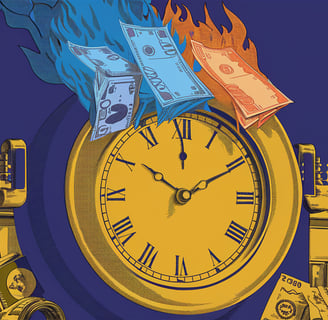
In the fast-paced world of tech companies, C-level executives face a unique paradox: their time is their most precious asset and their greatest constraint. Each day brings an unrelenting flood of emails, messages, meetings, fire drills, and strategic decisions. While time is the currency of innovation and growth, it's also a finite resource that's easily squandered without a deliberate strategy.
The challenge isn't just about managing time; it's about investing it wisely. Just as a product development executive carefully discovers and selects features with the maximum impact on customers and the highest return potential, you, as a leader, must make conscious choices about where you focus your energy. At Hyperboost Advisory, we help you navigate these choices using our proprietary Hyperboost Formula™, designed to shape your company into the next tech star by aligning your strategic efforts with principles and frameworks from Silicon Valley's big tech companies.
This article was created in response to a constant request from C-levels in our Hyperboost Formula™'s Stage 8 - Strengthen Product-Led Organizations' Executive Leadership, an executive mentorship program created to empower senior executives with the tools and strategies needed to lead the transformation of their organizations to ignite exponential growth. They need time to focus on strategic thinking, making the right decisions, and executing them!
The Financial Consequences of Poor Time Management
Several studies indirectly support the idea that ineffective time management leads to significant opportunity losses:
The Cost of Executive Time Mismanagement: According to a Harvard Business School study, executives spend an average of 23 hours per week in meetings, often leading to poor time allocation for strategic tasks. The study highlights the necessity for better time management practices among executives to avoid time sinks and focus on high-impact activities.
The Cost of Poor Meetings: A study by Doodle estimated that poorly organized meetings cost U.S. businesses $399 billion annually due to wasted time, lost productivity, and employee disengagement. Given that executives spend 23 hours per week in meetings, inefficient meeting management can have a substantial financial impact.
The Value of Strategic Time: A McKinsey study found that when executives dedicate sufficient time to strategic planning, their companies experience 1.5 times higher total returns to shareholders (TRS) compared to those who don't. This highlights the opportunity cost of poor time management, as executives who fail to prioritize strategic thinking miss out on potential financial gains.
The Impact of Delegation: A Gallup study revealed that companies with highly effective delegation practices experience 112% higher revenue growth compared to those with weak delegation. Since poor time management often leads to micromanagement and ineffective delegation, it can hinder growth and negatively impact a company's financial performance.
The Link Between Time Management and Stress: A study published in the Journal of Occupational and Organizational Psychology found a strong correlation between poor time management and high levels of stress in executives. Chronic stress is known to reduce productivity, increase absenteeism, and contribute to health problems, all of which have financial implications for organizations.
These studies collectively suggest that poor time management in executive roles can lead to significant financial losses through various channels, including wasted time in unproductive meetings, missed opportunities due to lack of strategic focus, slower growth due to ineffective delegation, reduced productivity, and increased healthcare costs due to stress. While the exact financial cost remains elusive, the evidence points to a strong correlation between effective time management and improved financial performance and well-being in executive roles. By prioritizing time management skills, executives can unlock significant potential for financial gains and long-term success.
Hyperboost Formula™'s Framework for Strategic Investment of Time
The fast-paced tech industry demands that C-level executives juggle numerous responsibilities, from driving product innovation to managing teams and making strategic decisions. As you saw in the studies above, effective time management is critical to balance these demands and ensure sustained growth and success.
To navigate this complex landscape, let's draw on the insights of the most influential expert in productivity: Stephen Covey, the author of the bestselling classic "The 7 Habits of Highly Effective People" and founder of FranklinCovey, a company specializing in productivity systems.
The framework foundation is based on Covey's Time Management Matrix, a simple and powerful concept for understanding how your time is allocated:
Quadrant I: Urgent & Important: Crises, deadlines, pressing problems. While unavoidable, spending too much time here leads to burnout and a reactive mindset. Think of a major product launch looming or a critical server outage demanding immediate attention.
Quadrant II: Not Urgent, but Important: Planning, relationship building, prevention, talent, and personal development. This quadrant is where true growth happens, yet it's often neglected. Imagine carving out time for strategic planning sessions, mentoring a promising employee, or investing in your professional development.
Quadrant III: Urgent, but Not Important: Interruptions, some meetings, popular activities. These tasks often feel urgent due to the demands of others but don't contribute to your long-term goals. This is where you might hear, "Don't make my urgency your lack of organization" when a team member presents a last-minute request that could have been planned earlier.
Quadrant IV: Not Urgent & Not Important: Doom scrolling, busy work, time wasters. This is the black hole of productivity, filled with activities like endless email threads, social media distractions, or sorting through low-priority notifications.
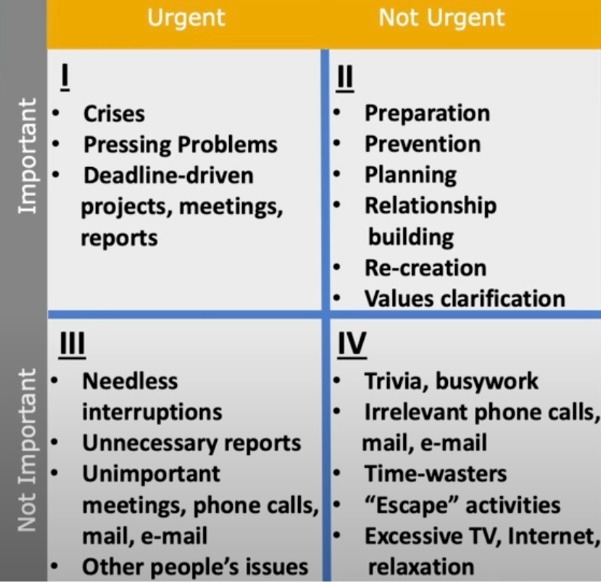

The Rock Analogy: Big, Medium, and Tiny
To visualize how these quadrants translate into your daily activities, consider the "big rock" analogy popularized by Stephen Covey. It is worth it to watch this short 4-minute video on Youtube before proceeding, where Covey very vividly demonstrates the concept: https://bit.ly/hyperboost-fml-s8-big-rocks-video
This is the correlation between quadrants and types of rocks:
Big Rocks (Quadrant II) represent your most important priorities, the non-urgent but essential activities that shape your life and career. Just as you can't fit all the big rocks into a jar after it's already filled with smaller ones (Quadrants I, III, and IV), you must prioritize these activities first ( "first things first", as Covey said).
For C-level executives, Big Rocks might include:
Health & Family: It is worth nothing to have spare time if your soul, mind, and body are not in great shape. Prioritizing mindfulness meditation, exercise, healthy eating, and sufficient sleep are the fundamental priorities. Quality time with family and friends comes right next, in second.
Strategic Thinking: Carving out time for deep reflection, brainstorming innovative solutions, and setting long-term goals for your company.
Talent Development: Scheduling regular one-on-one meetings and mentoring sessions to foster talent development. According to Bill George, Harvard Business School's Chair of Leadership and author of True North, his textbook on leadership development, the main attributes of a leader are Purpose, Mastery, and Autonomy. By focusing on these attributes during one-on-one meetings, you empower your team to achieve their full potential, aligning with the strategic importance of a growth mindset, one of the seven principles of Silicon Valley's tech stars and a pillar of the Hyperboost Formula™.
Building Relationships: Nurturing meaningful connections with your team, investors, and mentors. This could mean hosting team-building events or simply making time for informal conversations. This will help you lead by influence, not authority.
Personal Development: Continuously learning and growing, both professionally and personally. This might involve attending industry conferences, reading books, or taking courses to enhance your skills and knowledge.
Pebbles (Quadrant I) are your essential tasks that require immediate attention and contribute to your short-term goals.
For C-level executives, Pebbles might include:
Operational Responsibilities: Attending important meetings, managing budgets, reviewing financial reports, or making critical decisions that impact your team or company.
Problem-solving: Addressing urgent issues that arise unexpectedly, such as key customers' complaints, technical incidents, or supply chain disruptions.
Deadline-driven Projects: Completing time-sensitive tasks related to product launches, fundraising campaigns, or regulatory compliance.
Delegating Time-consuming Tasks: Allocating time to delegate incoming requests that generate time-consuming tasks, ensuring they are executed by others or automated where possible.
Sand (Quadrant III) includes urgent requests from others that may not align with your goals but still require some attention. As a leader, you understand the importance of being responsive and supportive, but it's crucial to maintain boundaries and ensure that sand doesn't crowd out your Big Rocks and Pebbles.
For C-level executives, Sand might include:
Unexpected requests: A colleague asking for urgent help on a project, an investor seeking a last-minute meeting, or a team member needing guidance on a pressing issue.
Fire drills: Addressing minor technical problems, responding to customer complaints, or dealing with unexpected logistical issues.
The saying "don't make my urgency your disorganization" serves as a reminder to politely but firmly push back on requests that could have been anticipated or planned by others interrupting your plans. It's about empowering your team to take ownership, plan ahead and proactively solve problems, rather than relying on you to swoop in and save the day.
Waste (Quadrant IV) includes time-wasters, distractions, and activities that offer little to no value. In the digital age, waste can easily take over your day if you're not vigilant.
For C-level executives, Waste might include:
Unnecessary meetings: Those that could have been an email or a quick phone call.
Endless email chains: Especially those you're cc'd on but don't require your direct input.
Real-time messaging: Mindlessly responding to every message or getting sucked into online debates.
"Doom Scrolling": Spending excessive time on social networks, consuming negative news or information that doesn't contribute to your well-being or productivity.
Timeboxing: Your Strategic Calendar
This strategy is used by highly effective leaders like Philipp Schindler, Google's Chief Business Officer, and tech titans like Bill Gates and Elon Musk, to manage their extensive global responsibilities efficiently. Now that you understand the types of "rocks" trying to get space in your jar, it's time to architect a calendar system that will strategically receive these rocks according to their quadrants! This is where timeboxing comes into play.
Instead of simply listing tasks on a task management system, and executing from there, you'll block off recurrent slots of time on your calendar, reserving time for tasks and activities of Quadrants II and I (Big Rocks and Pebbles, respectively), particular daily activities (like communications and delegations), and squeeze in buffer slots at the end of your workday for Quadrant III tasks that most certainly will appear during the day. There is no time reserved for waste (Quadrant IV) activities - it makes total sense when you hear yourself saying this, isn't it?
First, reserve the Big Rock time slots. These blocks, designated for your most important, strategic work (Quadrant II), should preferably be scheduled first thing in the morning when your mind is fresh and before urgent requests begin piling up, or at the end of the workday. This could mean a morning slot for vital activities that recharge your battery, such as exercise, meditation, or having breakfast with loved ones, and an afternoon slot for deep work like strategic planning, reading operation reports, conducting trend research, or professional development. Big Rock time slots should be blocked contiguously to allow for deep concentration and flow, thereby leveraging your creativity and productivity. Ensure there are no interruptions by turning off all notifications when these slots commence. I usually recommend that my coachees dedicate around 60% of their awake time ( approximately 9.5 hours) to these activities on workdays. I said awake time because Big Rocks are not only related to work; for example, morning exercise is for your well-being, taking children to school is for your family, and focusing for an hour on reading daily operations reports is for work. If you are a little A.D.D. like me (who isn’t these days), avoid reading emails or messages until your morning Big Rock time slot ends. If you do, you will likely be sidetracked by Pebbles and Sand, saying goodbye to your morning Big Rocks. Trust me!
Pebble time slots should be allocated next, throughout your day for the urgent and important tasks (Quadrant I) that keep your business running smoothly. This might include handling your inbox smartly, significant structured team meetings, operational tasks, and problem-solving. I suggest you dedicate around 30% of your awake time (5 hours) to these activities on workdays.
Sand time slots should be smaller, flexible "buffer" slots for handling those urgent but less important requests (Quadrant III). Group them if possible to minimize context switching, and warn your team that you will only act on their (not yours) urgent requests in this dedicated time block. Remember, it's okay to say no or delegate when appropriate. My tip is to allocate 10% of your awake time (1.5 hours) for Sand, right after your afternoon Big Rocks slot or right at the end of your workday. At that moment your mind will probably be tired, a perfect moment to deal with unimportant tasks.
The slots serve as a powerful visual reminder of your priorities. After defining your slots, it will take some time to move pre-schedule appointments around to the appropriate time slots, persevere on this, it will be worth it! For recurrent company-wide of C-Level meetings, you can negotiate, or plan your slots around those. There is a F A N T A S T I C way to achieve this at once with the Flow Time slots, continue reading and you will learn how.
Why Use This Technique?
Some critics argue that scheduling your day in advance limits flexibility and reduces unstructured free time. However, unstructured time often leads to procrastination rather than productive work towards future goals.
Parkinson's Law: "Work expands to fill the time allotted for it." (check the chart below).
Timeboxing provides a valuable time-limitation that can enhance productivity by:
Removing choice: You spend less time deciding what to do next thanks to a predetermined plan.
Intensifying focus: With a limited amount of time for each task, you’re less likely to waste it and more likely to concentrate fully on the task at hand.
Covey's Time Management Matrix
The article continues below...
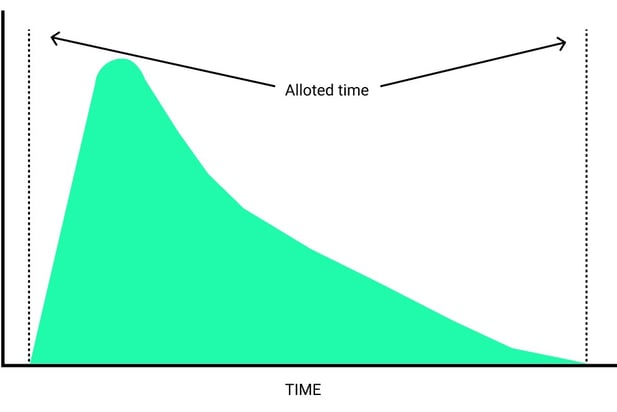

Parkinson's Law: "Work expands to fill the time allotted for it."
Subscribe to our newsletter
Immerse yourself in Silicon Valley's mindset, best practices, frameworks and latest technologies.
The Impact Effort Matrix: Your Decision Compass for Time Investment
Now that your calendar slots are ready to receive your Big Rocks and Pebbles, how do you decide which tasks deserve your attention first within each type of slot? For example, which one of several Pebbles in my task management system do I schedule first in my Pebbles slots? Should it be done today, tomorrow, or next week? What about my Big Rocks, how do I distribute them over the weeks and months? Should I do it in parallel with other Big Rocks to advance all at the same time?
This is where the Impact Effort Matrix, a simple but powerful decision-making tool, comes into play. It helps you assess the value of each task or activity by considering two primary factors: the potential impact on short and long-term goals, and the effort required to deliver the task or perform the activity.
The matrix is divided into four quadrants:
High Impact, Low Effort (Quick Wins): Tasks and activities in this quadrant offer significant benefits with minimal effort. Prioritize these tasks as they provide the best return on investment. Examples of high-impact, low-effort tasks for executives:
Pebbles (Urgent)
Addressing Immediate Team Concerns: Provides immediate support, prevents small issues from escalating, and maintains team morale with just a few minutes to read and respond to emails or messages.
Promptly Approving Time-Sensitive Requests: Keeps projects on track, avoids delays, and supports timely execution by reviewing and approving straightforward requests in just a few minutes.
Briefly Addressing a Sudden Crisis: Mitigates potential damage, ensures swift action, and provides clear direction to the team, handled quickly with initial response and delegation.
Quickly Replying to Stakeholder Inquiries: Maintains trust and transparency, addresses concerns promptly, and keeps stakeholders informed through short, focused communications.
Personally Intervening in Urgent Customer Issues: Enhances customer satisfaction, demonstrates commitment, and prevents churn by directly contacting the customer or overseeing the resolution process efficiently.
Making Quick Decisions on Urgent Matters: Avoids bottlenecks, ensures continuity, and supports agile responses by acting decisively based on available information, often within minutes.
Ensuring Compliance Deadlines are Met: Avoids legal penalties, ensures regulatory adherence, and maintains operational integrity through quick verification and delegation.
Providing Immediate Feedback on Urgent Deliverables: Facilitates timely revisions, ensures quality, and meets deadlines by briefly reviewing and commenting on key points to guide necessary adjustments.
Big Rocks (Strategic)
Strategic Planning Sessions: Ensures long-term alignment, drives strategic initiatives and sets clear company goals by dedicating focused time to planning and brainstorming.
Reviewing Key Performance Indicators (KPIs): Keeps the executive informed, allows for timely decisions, and ensures alignment with business objectives by regularly reviewing dashboards and reports.
Building High-Value Relationships: Enhances collaboration, fosters trust, and strengthens partnerships by scheduling regular touchpoints with key stakeholders, investors, and partners.
Personal Development Activities: Ensures continuous growth, keeps skills sharp, and maintains a competitive edge by spending time on professional development activities like reading industry reports or attending short webinars.
Health & Wellness Routines: Improves mental clarity, boosts overall productivity, and maintains physical health by integrating short, daily exercise routines or mindfulness practices into the schedule.
High Impact, High Effort (Major Projects): These tasks and activities are important but require considerable time and resources. Examples:
Pebbles (Urgent)
Leading a Crisis Management Team: Ensures swift resolution of critical problems, minimizes damage, and maintains business continuity. This involves intense focus and coordination over a short period.
Negotiating Key Deals or Contracts: Secures important business deals, fosters strategic partnerships, and drives revenue growth. This involves detailed preparation, multiple meetings, and extensive follow-up.
Implementing Immediate Strategic Changes: Keeps the company agile, responsive to market changes, and competitive. This requires detailed planning, execution, and monitoring.
Addressing Regulatory Compliance Issues: Avoids legal penalties, maintains operational integrity, and upholds the company’s reputation. This involves thorough review, adjustments to operations, and documentation.
Managing Major Product Launches: Ensures a successful launch, drives market impact, and meets strategic goals. This involves extensive coordination, marketing efforts, and execution.
Big Rocks (Strategic)
Developing a New Strategic Plan: Sets long-term direction, aligns the organization, and drives future growth. This requires deep analysis, cross-functional collaboration, and detailed documentation.
Building and Leading a Major Initiative: Drives significant business transformation, fosters innovation, and achieves strategic objectives. This involves significant time, resources, and leadership focus.
Executing a Merger or Acquisition: Expands business capabilities, increases market share, and achieves growth targets. This involves due diligence, negotiation, and integration efforts.
Overseeing a Comprehensive Digital Transformation: Enhances operational efficiency, improves customer experiences, and positions the company for future success. This requires significant investment in technology, change management, and process redesign.
Leading Organizational Change Management: Ensures smooth transitions, enhances employee engagement, and aligns the organization with new strategic directions. This involves extensive planning, communication, and leadership engagement.
For tasks and activities with High Impact, High Effort classification, adopt the "Minimum Viable Progress" (MVP) approach. This involves breaking down these significant "projects" into smaller, manageable tasks that can be completed incrementally. The MVP approach helps maintain momentum and ensures continuous progress without overwhelming your schedule. For example, instead of trying to complete an entire strategic plan in one go, aim to draft a section of it each day. This keeps the task moving forward steadily and makes it less daunting. For very long-term Big Rocks (several years' goals), schedule regular, short updates to maintain steady progress and keep the team engaged and focused. Use recurrent blocks in the appropriate slot type to reserve time for these projects, coordinating activities like a daily agile ceremony to guarantee their progress.
Low Impact, Low Effort (Fill-Ins): These tasks and activities align with the sand time slots previously discussed. They don’t offer substantial benefits for your goals, but engaging with them shows you empathize with others. For example:
Sand (Urgent)
Responding to Routine Information Requests: Provides necessary information or clarifications to team members or stakeholders. This involves brief, straightforward communication and can be done quickly during spare time.
Approving Routine Expenses: Ensures that minor operational expenses are approved and processed. This involves a quick review and approval process.
Attending Non-Critical Meetings: Participates in meetings that are not essential but may require your presence. This involves listening and occasionally contributing, which can be done during less productive times.
Handling Simple Administrative Tasks: Completes basic administrative tasks like signing documents, updating contact lists, or organizing files. This requires minimal effort and can be done in short bursts.
Providing Brief Feedback on Minor Issues: Gives quick feedback on minor issues or proposals that do not require in-depth analysis. This involves a brief review and response.
Participating in Informal Networking: Engages in casual networking activities or social interactions within the organization. This involves light, informal conversation and can be done during breaks or low-intensity periods.
Fulfilling Simple Requests for Help: Assists colleagues with minor tasks or questions that do not require significant time or effort. This involves offering quick help or guidance.
Reviewing Low-Priority Emails: Goes through non-critical emails and correspondence to stay updated. This involves skimming and occasionally replying to less important messages.
These low-impact, low-effort tasks are perfect for filling in gaps in your schedule, and helping others without detracting significantly from your high-priority responsibilities. They can be addressed in your buffer slots or spare time, and wherever possible, delegate them to team members to ensure you remain focused on more impactful activities. Delegation of these tasks not only frees up your time but also empowers your team and supports their growth and development. Remember: If a sand task can be done by others, DDD: Don't Do, Delegate! As an executive, every minute of your time is precious.
Low Impact, High Effort (Money Pit): They require significant effort but offer little value. These tasks and activities may align with sand at first, but they end up being waste.
Time Sinks (Waste)
Overseeing Micromanaged Projects: Closely supervising projects that could be effectively handled by team members. This involves constant oversight and detailed involvement, stifling team autonomy and growth.
Extensive Report Creation with Limited Use: Compiling detailed reports that are rarely read or utilized. This requires significant effort in data gathering, analysis, and formatting, offering little value to strategic decision-making.
Attending Lengthy, Unfocused Meetings: Participating in long meetings without clear agendas or outcomes. This consumes significant time and attention with minimal actionable insights and overall low impact.
Reviewing Low-Priority Proposals in Detail: Spending extensive time reviewing and analyzing proposals that are not critical to the business. This requires in-depth evaluation and feedback, offering minimal impact on strategic goals.
Managing Excessive Email or Messaging Threads: Engaging in prolonged email/message chains with minimal relevance to core responsibilities. This involves continuous reading and replying to emails/messages, which do not significantly contribute to key objectives.
Handling Frequent, Low-Impact Travel: Regular travel for meetings or events that do not yield significant results. This requires extensive planning and travel time, with outcomes that do not justify the time and resources spent.
Participating in Unnecessary Approvals: Engaging in approval processes for tasks that could be delegated. This involves detailed review and sign-off, adding little value to the overall workflow.
Editing Non-Essential Documents: Spending time on extensive edits and revisions of documents that are not critical. This involves detailed work with minimal impact on major business outcomes.
Aim to eliminate, automate, or delegate these to free up time for more impactful activities.
Moving Tasks from Task Management Systems to Calendar Using the Impact Effort Matrix
Before moving any task from the task management system to the appropriate recurrent slot on your calendar, mentally place the task in the Impact Effort Matrix. This quick mental exercise helps ensure that your time investment aligns with your strategic goals. If several tasks are tied up in the same quadrant, use -5...+5 scoring for each dimension. The tasks positioned on the top left of the quadrant (see article image) are the most important and urgent tasks. The ones on the bottom left are important but not urgent. By evaluating each task's potential impact and the effort required, you can prioritize effectively and make informed decisions about where to allocate your time.
Each task you decide to prioritize and execute must have a timeboxed block in the calendar, within the appropriate type of slot. This is not negotiable! This practice ensures that all tasks are accounted for and scheduled, preventing them from being overlooked or delayed indefinitely. By timeboxing tasks, you allocate specific periods for their completion, which promotes better time management and productivity.
Fitting Incoming Tasks and Getting Rid of Postponed Tasks
As new tasks arise, first assess their urgency and importance to classify them as Big Rocks, Pebbles, or Sand. Then, determine their impact and effort to place them in the appropriate quadrant of the Impact Effort Matrix. If you decide to prioritize them, timebox and assign tasks to the corresponding calendar slots, otherwise, move them to your task management system.
As you have buffer slots, Sand tasks can be easily fit into. If the buffers are already filled in, you need to postpone or eliminate a previously scheduled sand task.
If a new urgent Pebble comes up, don't hesitate to move other Pebbles to a future date to accommodate it. This flexibility allows you to adapt to changing circumstances while maintaining your overall commitment to your Big Rocks. You may also move back Pebbles to your task management system
Only postpone Big Rocks if a more impactful Big Rock is identified. Move the Big Rock task (or project) you decided not to keep in your calendar back to the task management system.
It is super important to notice how often you postpone tasks within the same quadrant. If a task repeatedly gets pushed back, it’s likely not as important or urgent as you initially thought. Letting go of it or delegating it to someone else is recommended. By regularly reflecting on and adjusting your schedule, you ensure that your time is spent on activities that truly matter and contribute to your strategic goals.
In summary, integrating the Impact Effort Matrix into your task management and calendar scheduling helps prioritize tasks effectively, ensuring that your time is invested in the most impactful activities. This approach promotes flexibility and adaptability, allowing you to manage your responsibilities efficiently while staying aligned with your long-term objectives.
Here’s how to do this using David Allen's Getting Things Done (GTD) methodology:
Capture: Collect all your incoming communications and potential tasks into a single, trusted system (a single inbox for everything). This means gathering emails, messages, tasks, and any other inputs in one place. Immediately delete non-essential emails, that do not contribute to your short or long-term messages. To help your collection time, get rid of the garbage: create email filters and unsubscribe to newsletters you never read. If this is your case, find help to deal with your FOMO (Fear Of Missing Out) communications, seriously, living with this mental illness just makes you work longer hours, have a constant feeling of being overwhelmed, and with time reduce even your body immunity. As a senior executive, if something really important happens, someone will get to you.
Clarify: Process each item to determine what it is and what action is needed. If an item requires action, decide what the next step is. If no action is needed, you can discard it, file it for reference, or set it aside for later review.
Organize: Tasks that can be delegated should be assigned to others immediately, and scheduled to follow-up in specific categories in your task management system. Tasks you need to handle yourself should be immediately moved to your system, allocating each one to category lists (or projects) that reflect their quadrant, based on their urgency and importance).
Reflect: Regularly review your task management system and calendar to ensure that tasks are up-to-date and that you’re focusing on the right priorities. This includes a daily review and a weekly review to update your plans and priorities. Use the Impact Effort Matrix to decide when to prioritize the tasks you allocated to quadrant categories when processing your centralized inbox. If you decide to prioritize them for execution in the next few days or weeks, move the task from the system to the appropriate calendar slots and define timeboxes to execute each one.
Engage: Use your organized productivity system, including task management, recurrent calendar slots, and planned timeboxed tasks, to guide your work. Focus on executing just the tasks you prioritized and planned previously, in each time slot type. This helps you stay on track and ensures that you’re working on the most important tasks.
Create recurrent communication time slots throughout the day to check emails and messages. Usually, two or three slots will do, one after your morning's Big Rock slots, another after lunch, and a third one after your afternoon Big Rock slots. Avoid the trap of constant notifications and batch-process your communication for greater efficiency. Inform your peers and team that the response time will increase, for the great reason of elevating your impact. They might be used to immediate responses, but this change will benefit greater productivity and results. Aligning this expectation is essential.
While you create the habit of only checking communications in these reserved slots, do this:
Turn Off Notifications: Disable all notifications on your devices to minimize distractions. Define a communication channel to be used for time-sensitive emergencies. The old phone call works wonders for that, as most of the younger executives love messaging, they already use the phone as the last resort.
Use Focus Tools: Utilize tools and apps designed to help you stay focused, such as website blockers, time management apps, and digital planners that prioritize important tasks.
Important: If managing your inbox consumes a significant portion of your day, hiring an executive assistant can be a highly effective investment with immediate payback.
By implementing the strategies I presented to you, and following the GTD flow, you can turn calendar and communication chaos into productivity. This approach helps you stay organized, focused, and efficient, ensuring that your time is spent on high-impact activities that drive your goals forward.
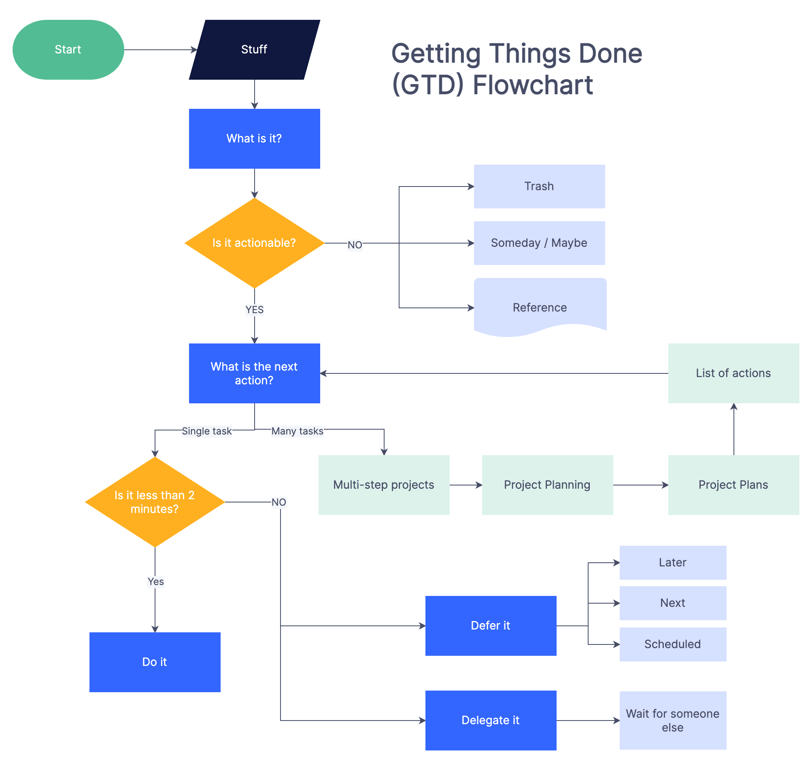

Productivity Hacks for Communication and Meetings
In the modern workplace, two of the most significant productivity offenders are unproductive meetings and chaotic digital communication. By addressing these areas with strategic practices, executives can reclaim valuable time and enhance their overall effectiveness. Below are expert recommendations to tackle these common productivity challenges:
Avoiding Unproductive Meetings
As studies have shown, unnecessary or unproductive meetings are a major drain on productivity. Renowned Silicon Valley coach Bill Campbell, who, among many other great leaders, mentored Steve Jobs, Larry & Sergei (Google founders), and Sheryl Sandberg, former COO of Meta, emphasized several key strategies to ensure meetings are productive and purposeful:
Create and Share Agendas in Advance: Every meeting should have a clear agenda shared ahead of time, highlighting topics that need input, brainstorming, or decisions from the group. This preparation sets clear expectations and allows participants to come prepared, making the meeting more focused and efficient (4).
Pre-Meeting Materials: Adopt the habit of sending reading and presentation materials at least one day ahead of time. Ensure that the actual meeting time is reserved for productive discussion and decision-making. Information should be sent via email or Slack, avoiding the use of meeting time to share details that can be reviewed beforehand.
Match Lists for One-on-One: For one-on-one meetings, both the manager and the team member should bring a list of five things to discuss and then match their lists to prioritize the most critical issues. This ensures alignment on priorities and addresses the most important topics5.
Data-driven Decision-Making: Avoid striving for consensus in meetings (or elsewhere), which can lead to groupthink and inferior decisions. Instead, focus on listening to all ideas and selecting the best one. If you choose to go with your idea, explain why and seek buy-in, or ask the team to "disagree and commit" to the decision (6).
Active Participation: Encourage engagement by fostering active participation and discussion. Ask attendees to share their thoughts and questions, making the meetings dynamic and inclusive (7).
Preparation Time Blocks: Set aside specific time blocks for meeting preparation (classified as Pebble Time) to ensure participants come prepared. This practice further enhances the productivity and effectiveness of meetings.
Turning Inbox Chaos into Productivity
Digital communication tools, including email and real-time messaging channels like Slack, present unique challenges. They are both communication platforms requiring responses and task inboxes that generate actionable items. To manage them effectively, it's essential to separate communications from the tasks they create.

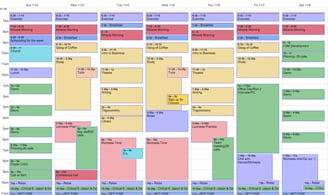
A calendar with slots defined for each type of "rock"
and timeboxed tasks using previous reserved slots.
Reflection Time: A Small Investment For Executives, a Big Step for Exponential Performance
Research supports the idea that taking just a few minutes at the end of the workday to reflect on your day can significantly improve both personal and professional performance. A study published in the Harvard Business Review1 found that employees who spent 15 minutes at the end of the day reflecting on lessons learned performed 23% better after 10 days than those who did not reflect. This practice helps track progress, maintain a positive mindset, and set clear future goals.
Reflection Time should have a dedicated block at the end of your workday. This is a Big Rock that demands low time investment but yields significant long-term benefits. Reflecting on your day, identifying areas for improvement, and planning for tomorrow can lead to substantial personal and professional growth. Just imagine, if you improve 1% daily with reflections, that leads to a 3678.34% improvement over a year. Each improvement builds upon the previous one, resulting in exponential performance growth.
Renowned leadership coach Marshall Goldsmith emphasizes the importance of daily reflection to enhance results and well-being. Here’s a set of questions recommended by Marshall Goldsmith to guide your Evening Reflections:
Did I do my best to be aware of my thoughts and emotions today?
Did I do my best to be present at each moment today?
Did I do my best to set clear goals today?
Did I do my best to make progress toward my goals today?
Did I do my best to find meaning today?
Did I do my best to be happy today?
Did I do my best to build positive relationships today?
Did I do my best to be fully engaged today?
To perfect that reflection, I recommend adding an opening question to your reflection:
What am I grateful for today?
In a study published in Applied Psychology: Health and Well-Being (2), participants that wrote a few sentences each week about things they were grateful for (even little things we take for granted, like having electricity and sewage at home,) experienced increased optimism and had fewer doctor visits after 10 weeks compared to those who focused on daily irritations (3). This practice of gratitude journaling can help instill the habit of acknowledging and appreciating positive aspects of life, and bring you universe-grade energy to your days. Robert Emmons has conducted multiple studies on the link between gratitude and well-being. His research confirms that practicing gratitude effectively increases happiness and reduces depression (1). Emmons has authored several papers on the psychology of gratitude, emphasizing its importance for overall life satisfaction.
By integrating these questions into your daily routine, you create a powerful habit of self-awareness, continuous improvement, and well-being. This practice not only fosters personal growth but also enhances your leadership effectiveness, driving both your success and that of your organization.


Unleash the Creativity and Productivity of Your Entire Company With "The Flow Time"
Research has shown that interruptions caused by emails and notifications can significantly impact productivity and financial costs. Employees in knowledge-intensive professions are interrupted an average of 15 times per hour, translating to one interruption every four minutes. According to Basex research, interruptions cost the U.S. economy $588 billion a year. This includes the cost of mindlessly replying to messages and notifications as soon as they come, generating several interruptions throughout the day, and the need to restore one's context memory to resume working on the interrupted task.
Recommendations include reducing the prominence of interruptions, restricting the use of email-to-all messages, and checking email less frequently (as we talked about above). Interruptions lead to a notion of working faster, but the price is high: increased stress, frustration, and time pressure. Minimizing interruptions can significantly improve productivity and reduce financial losses for organizations, as they enable one's Flow State.
Flow, a concept introduced by Mihaly Csikszentmihalyi, refers to a state of deep focus and immersion where individuals are fully engaged in an activity. In this state, people often lose track of time and experience heightened creativity and productivity. Flow occurs when one's skills are well-matched to the challenges at hand, creating a balance that fosters intense concentration and enjoyment in the task. Achieving flow requires uninterrupted time and a conducive environment that minimizes distractions.
Flow Time Slots: Enabling Optimal Performance
The financial impact is substantial, and tolerating an interruption culture at your company jeopardizes profits. I created the concept of Flow Time slots to test if it would improve productivity, creativity, and innovation when I was working with Xerpay. It functioned so well that CB Insights listed the company as the top 250 most innovative fintech in the world due to the incredible platform and products the product teams created during this time!
Establishing the Flow Time is a company-wide effort to reserve continuous blocks of time dedicated to creative or focused work, enabling employees to enter this optimal state of productivity. Typically scheduled towards the end of the workday for two to three hours, these slots of time are dedicated to the company's product teams to deal with the company's Big Rocks, and to the operations and support teams to produce like crazy (for example, calling several prospects or empty customer service inbox emails).
Here’s how Flow Time Blocks work:
Dedicated Time Blocks: The People/HR team sends a recurring calendar invite to everyone in the organization. These blocks are non-negotiable periods reserved for deep work, free from interruptions.
Calendar Integration: Team members accept the invite and activate the calendar feature that automatically rejects any meeting invitations during these blocks. This ensures that no meetings are scheduled, preserving the sanctity of Flow Time slots.
Turn Off Notifications: Before entering Flow Time Blocks, turn off all notifications, especially from Slack or similar messaging tools, and your smartphone—the main culprit with social media notifications.
Align with External Stakeholders: Everyone in the company should make a deal with stakeholders, like partners, investors, and families, that if something truly urgent happens, they should call. Also, they need to ensure that the contacts of people allowed to interrupt them should be listed on the favorites of their smartphones, and this latter are configured to allow calls from these contacts even in 'do not disturb' mode.
Executive Support: Executives are often tempted to schedule urgent meetings during these blocks. While there can be exceptions, leaders must understand the importance of Flow Time slots and respect them. They should also seize these slots and lead by example, to foster a culture of focused work, productivity and creativity.
The benefits of implementing Flow Time Blocks are significant. While we haven't measured the productivity increase scientifically, these initiatives receive an average approval rating of around 90% from employees across all departments. Feedback consistently highlights that Flow Time slots enable substantial leaps in creativity, innovation, quality, and results over the mid-term. By creating an environment conducive to entering a state of flow, companies can unlock their employees' full creative potential, driving innovation and achieving remarkable outcomes.
Embrace the Power of Strategic Investment Of Time
As a C-level leader, you're not just a manager of tasks; but the architect of your company's future. By intentionally choosing how to invest your time, you can achieve your most ambitious goals by prioritizing your Big Rocks, and consistently moving closer to your long-term vision. Build strong relationships by dedicating time to your team, mentors, and partners, fostering a culture of trust, collaboration, and innovation. Maintain work-life balance by carving out time for personal development and well-being, avoiding burnout, and sustaining your energy and focus. Empower your team by setting clear boundaries and delegating effectively, cultivating a more independent and capable workforce. Stay adaptable by regularly reflecting on your progress, adjusting your strategies as needed, and staying ahead of the curve.
Remember, the power of choice is in your hands. By adopting these principles and making conscious decisions about investing your time, you can unlock your full potential as a leader and create a lasting impact on your company and the world.

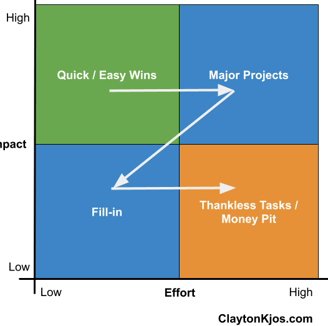


The Impact Effort Matrix and the optimal prioritization path
References follows below...
Subscribe to our newsletter
Immerse yourself in Silicon Valley's mindset, best practices, frameworks and latest technologies.
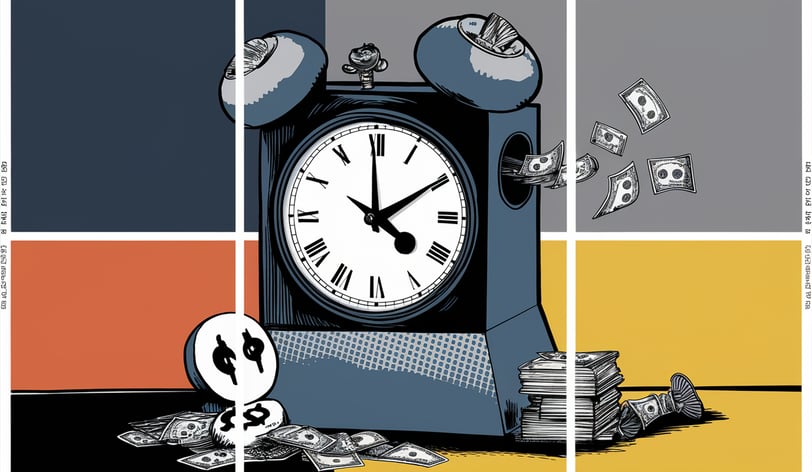

References:
Watch these YouTube videos for an in-depth look at the building blocks of the method discussed in this article:
Studies:
Di Stefano, G., Gino, F., Pisano, G., & Staats, B. (2014). Learning by Thinking: How Reflection Aids Performance. Harvard Business Review.
What is Gratitude and Why Is It So Important? (positivepsychology.com)
Immerse yourself in Silicon Valley's mindset, best practices, frameworks and latest technologies.
Hyperboost Ltd. - Global Innovation, Transformation and Education.
We work 100% mobile from somewhere in the world.


